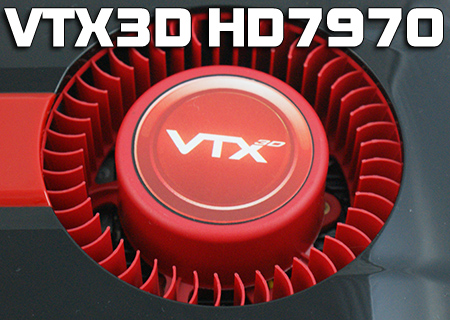VTX3D HD7970 PCIE2 vs PCIE3 Review
Introduction
I don’t think it would be either a great stretch, nor revealing a particular dark secret, to say that we never really took to the HD6970 here at OC3D. After the absolute magnificence that was the HD4870 and HD5870 AMD really dropped the ball with the HD6970 which was too hot, too loud and just not quick enough to even stay close to the high-end nVidia cards.
So it’s with a certain sense of trepidation that we take a look at the HD7970. At least after the HD6970 our expectations are dampened somewhat, so we’re hopeful that this will impress us.
VTX3D, the VTX standing for Vertex fact fans, have been around for a couple of years and stick solely to the Radeon line of products. But enough of the preamble, what’s new?
Technical Specifications
To say the technical specifications of the HD7970 are lengthy is somewhat of an understatement. 3GB of GDDR5 is only the beginning. The major new feature is the new 28nm Tahiti XT core which comes with a stunning 2048 stream processors and enough bandwidth and polygon shifting abilities to excite even the most jaded user. The GCN (Graphics Card Next) architecture is a complete redesign of the old AMD GPUs, and should lead to a similar increase in performance that we’ve seen from things such as Sandy Bridge, where the pure numbers don’t tell the full story of the available number crunching capabilities.
- Up to 925MHz Engine Clock
- 3GB GDDR5 Memory
- 1375MHz Memory Clock (5.5Gbps GDDR5)
- 264GB/s memory bandwidth (maximum)
- 3.79 TFLOPs Single Precision compute power
- 947 GFLOPs Double Precision compute power
- GCN Architecture
- 32 compute units (2048 Stream Processors)
- 128 Texture Units
- 128 Z/Stencil ROP Units
- 32 Color ROP Units
- Dual Geometry Engines
- Dual Asynchronous Compute Engines (ACE)
- PCI Express 3.0 x16 bus interface
- DirectX® 11-capable graphics
- 9th generation programmable hardware tessellation units
- Shader Model 5.0
- DirectCompute 11
- Accelerated multi-threading
- HDR texture compression
- Order-independent transparency
- OpenGL 4.2 support
- Partially Resident Textures (PRT)
- Ultra-high resolution texture streaming
- Partially Resident Textures (PRT)
- Image quality enhancement technology
- Up to 24x multi-sample and super-sample anti-aliasing modes
- Adaptive anti-aliasing
- Morphological Anti-Aliasing (MLAA)Â Â
- 16x angle independent anisotropic texture filtering
- 128-bit floating point HDR rendering
- AMD Eyefinity multi-display technology
- Up to 6 displays supported with DisplayPort 1.2 Multi-Stream Transport
- Independent resolutions, refresh rates, color controls, and video overlays
- Display grouping
- Combine multiple displays to behave like a single large display
- AMD App Acceleration
- OpenCL 1.2 Support
- Microsoft C++ AMP
- DirectCompute 11
- Double Precision Floating Point
- AMD HD Media Accelerator
- Universal Video Decoder (UVD)
- H.264
- VC-1
- MPEG-2 (SD & HD)
- MVC (Blu-ray 3D)
- MPEG-4 Part 2 (DivX/Xvid)
- Adobe Flash
- DXVA 1.0 & 2.0 support
- Enhanced Video Quality features
- Advanced post-processing and scaling
- Deblocking
- Denoising
- Automatic deinterlacing
- Mosquito noise reduction
- Edge enhancement
- 3:2 pulldown detection
- Advanced video color correction
- Brighter whites processing (Blue Stretch)
- Independent video gamma control
- Flesh tone correction
- Color vibrance control
- Dynamic contrast
- Dynamic video range control
- Advanced post-processing and scaling
- Universal Video Decoder (UVD)
- AMD HD3D technology
- Stereoscopic 3D display/glasses support
- Blu-ray 3D support
- Stereoscopic 3D gaming
- AMD CrossFireâ„¢ multi-GPU technology
- Dual, triple or quad-GPU scaling
- Cutting-edge integrated display support
- DisplayPort 1.2
- Max resolution: 4096×2160 per display
- Multi-Stream Transport
- 21.6 Gbps bandwidth
- High bit-rate audio
- Quad HD/4k video support
- 3GHz HDMI 1.4a with Stereoscopic 3D Frame Packing Format, Deep Color, xvYCC wide gamut support, and high bit-rate audio
- Max resolution: 4096×3112
- 1080p60 Stereoscopic 3D
- Quad HD/4k video support
- Dual-link DVI with HDCP Max resolution: 2560×1600
- VGA Max resolution: 2048×1536
- DisplayPort 1.2
- Integrated HD audio controller
- Output protected high bit rate 7.1 channel surround sound over HDMI with no additional cables required
- Supports AC-3, AAC, Dolby TrueHD and DTS Master Audio formats



